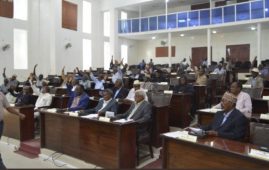Somalia is a fragile state, located in the horn of Africa that has emerged from a two-decade-long civil war that caused significant damage to the country’s economic and social infrastructures. In 2012, the Federal Government of Somalia was elected and recognized by the international community. Post-war conditions continue to be difficult, however, with poverty widespread and weak institutional capacity.
Somalia faces numerous challenges on its quest for peace, stability, and economic prosperity. The recent drought and famine will test the country’s resilience to provide humanitarian assistance and will require help from the international community. The government’s recent policies demonstrate its strong commitment to improving the state of the country and Somalis’ livelihoods.
Here are the six things to know about Somalia’s economy since the country resumed relations with the international community five years ago.
1/ The drought is severely affecting vulnerable populations.
The harsh impact of the ongoing drought on the agricultural sector has put about 6.2 million people (about half the Somali population) in need of assistance and at risk of food insecurity, prompting an urgent need for humanitarian and financial assistance from the government and the international community.
The government will also need to better coordinate and monitor humanitarian aid distribution amid security challenges across some regions with a focus on the most affected regions.
![Photo - Mogadishu, Somalia [Credit travelchannel05]](https://hornaffairs.com/wana/wp-content/uploads/2017/04/Photo-Mogadishu-Somalia.jpg)
2/ Donors’ support is key.
The Somali economy is sustained by donors’ grants, remittances, and foreign direct investment mostly by the Somali diaspora. Since 2013, the donor community has given over $4.5 billion in humanitarian and developmental grants, which is essential in contributing to finance Somalia’s trade deficit of nearly 55 percent of GDP (average during 2013-16). The current drought is expected to slow economic activity and raise inflation this year, thereby making donor support all the more critical to sustain growth.
3/ Tackling unemployment is crucial for political stability.
The unemployed youth population (about 67 percent) contributes significantly to irregular migration and participation in extremist activities, including Al-Shabaab—the militant jihadist group—which is viewed as another form of employment.
With very high youth unemployment and low overall labor force participation (particularly by women), the Somali authorities established the National Development Plan that focuses on the following key areas: how to achieve higher economic growth, create jobs, and absorb the Somali refugees returning from Kenya; remittances flows; and prioritizing social safety nets and pressing humanitarian conditions.
4/ Preparations for currency reform are under way to help strengthen governance.
As part of a wider Somali reform initiative, the Central Bank of Somalia and the Federal Government of Somalia are preparing to reissue new Somali shilling banknotes—for the first time in 26 years—to combat the existing massive counterfeiting in the country, restore confidence in the national currency, and to allow the central bank to start implementing monetary policy. The IMF is helping the authorities to implement the measures that need to be in place for the launch of the new currency.
5/ The IMF is working closely with Somalia.
Since resuming its relationship with the country in 2013, the IMF has concluded two annual economic assessments—the first in 2015—marking the first IMF consultation with the country since 1989. Because Somalia is in arrears with the IMF it cannot benefit from IMF loans; however, the authorities have engaged with the IMF in the context of a 12-month staff-monitored program.
This has helped create a framework to support Somalia’s economic reconstruction efforts, rebuild institutional capacity, and establish a track record of policy and reform implementation. The first review of this program was completed in February 2017.
6/ Technical assistance is helping.
Somalia is among the largest beneficiaries of IMF technical assistance—which helps build institutional capacity—receiving over 70 technical assistance and training missions since 2014. Tangible progress is being made in budget preparation and fiscal reporting, currency reform, and financial sector reporting and licensing. For example, the authorities have been able to prepare a national budget for 2014-2017 and since January 2015, the government produced its first monthly fiscal reporting data.
Starting from a very low capacity and a mix of Islamic and western accounting systems, central bank staff have developed a bank licensing framework, methods for periodic reporting by commercial banks, a system for bank financial analysis, and a supervisory scoring system that monitors the overall health of a bank. As Somalia continues to engage more with the international financial institutions, the IMF will deepen and scale up its capacity-building efforts as necessary.
***************
* Previously published on IMF on April 11, 2017





